- Getting around Lijiang. Dont stay in the Old Towns more than 2 days, there is nothing to do. KRISS Oct 9, 2013 05:46
- 2013 Beijing Temple Fair BENNYLAU Feb 26, 2013 03:29
- Malaysian traveling from KUL - LAX vis Shanghai PVG ZATI_DY Jan 3, 2013 20:15
Dodging Raindrops in Dali
- Views: 6362
- |Vote: 0 0
- |Add to Favorites
- |Recommend to Friends
The Weather
Had I wronged the weather in another life ? Perhaps – but those who read the guidebooks will also note that summer is the rainy season in the province of Yunnan (云南), so it is not unlikely that you’ll find yourself under the same leaden skies that I once did, wondering what you could have possible done to deserve it.
Though it really is impossible to complain. The temperatures hang around the mid-twenties Celsius despite the rain and the ferocious looking clouds add a certain photogenic gravity to the scenery at the same time as obscuring it.
For those on an open itinerary, the option of sitting the rain out in one of Dali’s many café-cum-bars is a pleasant enough pastime, but for those of us on a ruthless schedule, time allows for no such luxury. If getting wet becomes the order of the day, don’t worry, at least you won’t have been the only one!
Dali: Past & Present
I arrived in Dali (大理), via Xiaguan (下关, see information at the end) in the rain. Even so, it was possible to make out the 4000m Cangshan (沧山) mountain range in the distance, interspersed with bushy white cloud. The mountains looked ponderous and alluring against the old city gate and shiny streets lending Dali a fairytale appeal upon first impressions.
Dali City was originally surrounded by a 6-kilometre city wall, of which now it is possible to walk along a small section a few hundred meters long. A great deal of the wall still remains, encircling the city. The wall was 8 meters high and 7 meters wide and backed up by a defensive moat.
Four great gates stand in the North, South, East and West of the city and the streets run in a grid like pattern within the walls, making it easy to navigate. Canals run through areas of the city and the tiled buildings with their courtyard gardens feel like they belong in another era. The courtyard gardens are brimming with flowers and plants, all of which added to an old-world magic.
This impression was never quite to leave me, although the reality of Dali is very much 21st Century and does much to lessen its own appeal. Beneath the curling, traditional roofs, souvenir shops do brisk business, tour groups are led around the city by guides dressed as members of the Dai minority and the rest of us chop up the city into photographs, aiming to capture that elusive sense of the ancient amidst the modern.
Vestiges of Dali’s substantial history remain visually in the form of the city’s wall, gates and some buildings, but as these have been renovated to cater to the tourist industry, it’s difficult to credit them as authentic. Dali is a reminder that it is not easy to maintain historical integrity against the onslaught of modernisation.
Nevertheless, it is a mistake to write the city off as charmless, as any early morning walk will reward you with pre-tour-group peace and a chance to exchange a smile and 1RMB for some freshly baked steamed bread. Likewise, take a twilit stroll beneath the silhouette of the castellated walls and you might imagine you’ve heard the ghosts of the battle cries of the Mongol hordes, seven centuries ago, razing Dali to the ground.
The 3 Pagodas
Two kilometres north-west of Dali, and visible from the city are the famous 3 Pagodas (三塔寺). Hiring a bike is a great way to get there, or if you’re feeling less energetic, why not hail one of the many horses and carriages plying the route.
The 3 pagodas date from around 900AD and were originally part of a Buddhist monastery. Nothing of the monastery now remains and the towers themselves were renovated in the late 1970s and a new bell tower was added to the complex in 1997. From the top of the 3-storied bell tower there are magnificent views out over Erhai Lake and the mountains beyond.
The main pagoda is square and stands at almost 70 meters in height, at its base are four Chinese characters “永镇山川” that stand for “Everlasting Sovereignty and Peace”. Legend has it that the copper bird wings on the four corners of the top tier of the pagoda, cast a spell over demons in Erhai Lake that prevents them from surfacing. Two smaller octagonal shaped pagodas flank their square partner standing at 43 meters tall. It was not possible to climb any of the pagodas when I visited!
The grounds in which the pagodas stand are a pleasant stroll through topiary and vast dark green pines and ranks of new evergreens have been planted leading up to a temple and museum. The museum is a good place to escape from the rain for a while, housing a large collection of cultural relics from the area. A small, and easily missed lake provides a famous view of the 3 pagodas reflected in its mirrored surface.
Erhai Lake
Erhai (Ear Sea) Lake (洱海湖) is very close to Dali and well worth taking the time out to explore. The lake covers almost 250km and is one of the largest fresh water lakes in China. There are many villages around its perimeter as well as parks, temples and pavilions.
Boats and ferries crisscross Erhai and it’s possible to go to and from almost any destination, it’s also possible to take your bicycles with you if you wish – the locals all do it! There are also islands on the lake, housing temples, which can be visited although you must usually pay a small entrance fee to explore the island itself.
There really is nowhere to escape from the rain here though, except to take a ride on one of the covered ferries, which is what I found myself doing. I cycled along a portion of the lake, until fed up with the wet-dry-wet-dry nature of the day’s showers-then-sunny weather, I decided to take a trip on a boat. Perhaps because of the mid-summer rain, I was able to negotiate a 50% discount off the ticket price and gratefully sank onto the warm, dry ferry.
The cruise I took was around 3 hours in total, with a good 2 hours cruising on the lake and stops at Putuo and Jinsuo Islands. It rained the entire time. It was pointless to explore the islands in the downpour that seemed to have settled in for the whole day. The magnificent scenery to be found here, mountains and meadows, remained hidden beneath a smudge of grey that stubbornly refused to move and the renowned placid surface of the lake writhed under a bombardment of raindrops. I counted myself, not for the last time here in Dali, unlucky.
The Cangshan Mountains
For those mesmerised by mountains, a trip to Dali wouldn’t be complete without an excursion into the Cangshan range that edges this city. If you find your way into one of the small tourist information centres dotted around the city, you can pick up tickets and a bus that will take you up into the mountains for day’s exploring. It is possible to spend much longer on hiking trails around the area, but if you only have a day to spare, this is great option for making the most of the mountains.
Zhonghe Temple (中和寺) is located on Mt Zhonghe, part of the Cangshan range, and can be reached either on foot or by taking a cable car. I decided to take the cable car, as the weather had not improved and the rain continued to hammer down. The cable car makes a steady ascent of the mountain that takes around 20 minutes to reach the top, skirting over a diverse range of tree, bamboos and other greenery and offering superb views of Erhai Lake on a clear day.
This day, I was treated to the mists and cloud of the Cangshan range, and little else. At the top, steep and winding stairs traverse the pine-treed slopes and lead off to temples, waterfalls and forested walks. The rain effectively rendered this a useless activity as the steps were slippery, the views non-existent and without my umbrella I would have been saturated.
As it was, I explored the nearby giant, stone Chinese chess set and watched the cable-cars disappearing into the mists above it. Each piece came up to my knees and was around a meter in diameter. I also made my way to a waterfall, that defied the rain to remain majestic as a white tumbling torrent falling down into a blue pool of crystal clarity. The waterfall was surrounded by rocky cliffs that were painted with vibrant green mosses and gravity defying ferns.
My final stop found me taking a steep stone staircase up into the fingers of the pine trees. I found, quite by chance, a tiny teahouse with a stone floor and wooden beams. I ordered a pot of green tea and took shelter here, all alone, from the worst of the rain. A Chinese couple sat quietly reading in a corner.
A well-known English idiom goes “every cloud has a silver lining”. Sipping my tea and listening to the rain thumping on the wooden roof, I conceded the simple truth of this: that the peace and tranquillity of the teahouse, and Dali itself, were well worth the price of getting wet.
Information (July 2005)
Getting There:
At the time of visiting, buses were still taking travellers to Xiaguan (also known as New Dali) rather than to Dali itself. Even though I had the details written in Chinese and also checked the Chinese on the bus and the ticket, I still ended up in Xiaguan. Fortunately it is a 25 minute, 1RMB, bus ride to Dali from Xiaguan. Public buses can be taken from outside the Xiaguan bus station.
From: Kunming (昆明)
To: Xiaguan (下关)
Time: 7.40am – 12.40pm (5 hours)
Accommodation:
I stayed in a small hotel just outside the city gates where the public bus from Xiaguan dropped me. A twin room in August, hot water, air-conditioning was 60RMB.
3 Pagodas
Entrance fee: 52RMB
Ferry on Erhai Lake
Ticket price was 100RMB per person.
I was offered a 50% discount, probably because of the weather: 50RMB.
Other
I want to note that Dali is the only place in China I have ever been approached by a Chinese person selling drugs!



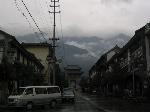
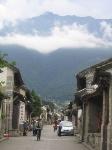
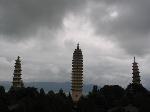
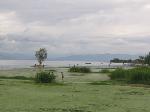
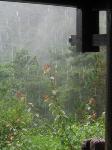
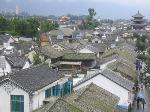
 Copyright © 1998-2025 All rights reserved.
Copyright © 1998-2025 All rights reserved.